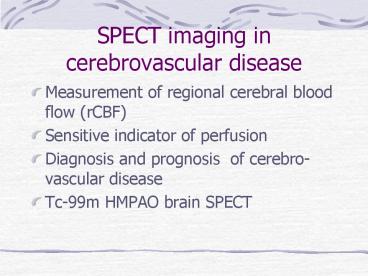SPECT imaging in cerebrovascular disease - PowerPoint PPT Presentation
1 / 15
Title:
SPECT imaging in cerebrovascular disease
Description:
SPECT imaging in cerebrovascular disease. Measurement of regional cerebral blood flow (rCBF) ... Cerebrovascular reserve is prognostic for postoperative outcome ... – PowerPoint PPT presentation
Number of Views:164
Avg rating:3.0/5.0
Title: SPECT imaging in cerebrovascular disease
1
SPECT imaging in cerebrovascular disease
- Measurement of regional cerebral blood flow
(rCBF) - Sensitive indicator of perfusion
- Diagnosis and prognosis of cerebro-vascular
disease - Tc-99m HMPAO brain SPECT
2
SPECT perfusion image
- Acute brain ischemia
- Perfusion defects after resolution of TIA
- Cerebral infarction
- Delayed ischemic deficits after SAH
- Determine pathophysiological mechanisms of stroke
- Monitor medical and surgical therapies
3
Normal tracer uptake
- Symmetric distribution
- Higher radioactivity gray matter, basal
ganglion, occipital cortex, cerebellum - Lower radioactivity white matter, ventricles
4
Abnormal tracer uptake
- Absent
- infarction, trauma, surgical resection
- Reduced
- ischemia, dementia, depression,
seizure(interictal) - Increased
- luxury perfusion, seizure(ictal)
5
Stroke 1
- SPECT superior to CT/MRI in detecting cerebral
ischemiaearlier larger - rCBF imaging effective in acute phase, less
sensitive in the subacute phase - -8h SPECT-80 CT-20
- -72h SPECTCT/MRI
6
Stroke 2
- False negative lacunar infarctions, luxury
perfusion(520 days) - Crossed-cerebellar diaschisis continues even
during luxury perfusion - Classifying stroke subtypes for treatment,
recurrence, recovery and mortality
7
Cerebrovascular reserve 1
- Increase the sensitivity of detecting perfusion
failure - Assess the need for acute interventions following
stroke or the risk status for secondary strokes - Useful in detecting ischemic sequelae in TIA,
stroke, AVM, SAH pt
8
Cerebrovascular reserve 2
- Brain stress test vasodilatory response to CO2
or acetazolamide - --compare resting images and vasodilated images
(2030min after acetazolamide injection) - --diseased or at-risk areas show little or
no response
9
Prognostication
- SPECT/CT volume defect sizeslarger ratios with
better outcomes - Flow index, density of counts/volume of defect on
SPECT correlates clinical recovery at 1 month - IMP uptake delayed(4h)/early(lt1h)larger with
more viable brain tissue and better clinical
outcomes
10
Transient Ischemic Attacks (TIA)
- Severity of persistent hypoperfusion
- Response of an ischemic area to medical or
surgical intervention - Identify pt at high risk for early stroke
following a TIA (persistent reduction in rCBF of
gt30 with high risk of subsequent infarction) - Sensitivity declines with time, (24h60,
1wk40) can be enhanced by acetazolamide stress
test
11
Monitoring therapies
- Determine pathophysiology after successful
therapy - In thrombolytic and anticoagulant treatments,
changes in artery patency and recanalization can
be evaluated.
12
Subarachnoid hemorrhage (SAH)
- Provide early evidence of cerebral ischemia due
to vasospasm after SAH - Vasospasm decrease rCBF, increase cerebral blood
volume - Delayed cerebral ischemia with vasospasmfactors
of recurrent hemorrhage in the morbidity or
mortality of SAH
13
Arteriovenous malformation (AVM) 1
- Complications
- Intracerebral/intraventricular bleeding
- Seizure
- Intracerebral steal due to AV shuntingproduce
ischemia - Cerebrovascular reserve is prognostic for
postoperative outcome
14
Arteriovenous malformation (AVM) 2
- Reserve categorization
- Normal
- Increased (pathological vasodilatation)
- hyper-responsiveness to acetazolamide in
regions of steal in the resting state - Failed (no vasodilatory reserve in steal areas)
15
Others
- Vascular diseasemigraine, vascular dementia,
transient global amnesia - Alzheimers disease
- Head injury
- Epilepsy
- Brain death































